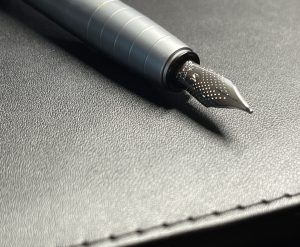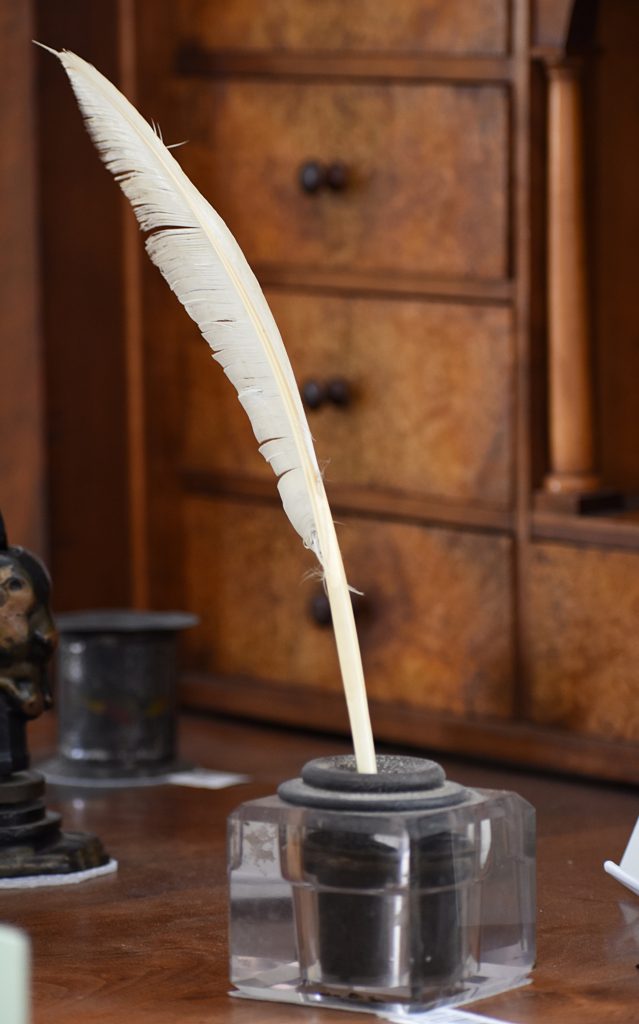By Geoffrey Fuller, 6/9/2021, updated 10/27/2021.
 The fountain pen has been an enduring monument to our quest for productivity and efficiency. From the quill to the typewriter, and currently, to the qwerty keyboard touch screens on our phones, we’ve always reached for a faster form of recording our thoughts. However, who invented the fountain pen? Really, the question should be answered by which critical advances led to the most enduring and successful design. It was one innovation progressively set upon the last innovation. The ending result of multiple innovations was the fountain pen.
The fountain pen has been an enduring monument to our quest for productivity and efficiency. From the quill to the typewriter, and currently, to the qwerty keyboard touch screens on our phones, we’ve always reached for a faster form of recording our thoughts. However, who invented the fountain pen? Really, the question should be answered by which critical advances led to the most enduring and successful design. It was one innovation progressively set upon the last innovation. The ending result of multiple innovations was the fountain pen.
For centuries, the quill was a longstanding instrument for writing. It naturally had a capillary action created by the hollow shaft in the feather. It could hold a small amount of ink in the hollow shaft of the feather, and ink would flow to the carved end of the feather via capillary action.
The capillary action is created by combining the ink’s surface tension and the affinity the ink displays toward the material of the narrow passageway. If the corridor is narrow enough, such as the point of a pen, the ink will display a concave shape to its visible surface tension. This concave shape is due to the affinity, or attraction that the ink has with the material of the thin tube. This affinity will naturally pull the liquid through the tube by itself.Capillary action is the critical process that allows ink to flow to the writing tip of both quills and modern fountain pens. Specifically, this refers to the natural process of liquid being pulled through narrow pathways without any additional assistance.
 A quill could hold a small amount of ink through a short-term capillary action, which would then draw the ink into the carved writing point. But, of course, at some point, someone said, “Really?? Thither hath got to be something better than constantly dipping my feather into an inkwell! Thine parchment script should have been done an hour ago. Fie upon it!”
A quill could hold a small amount of ink through a short-term capillary action, which would then draw the ink into the carved writing point. But, of course, at some point, someone said, “Really?? Thither hath got to be something better than constantly dipping my feather into an inkwell! Thine parchment script should have been done an hour ago. Fie upon it!”
Then, several centuries later, we found a way to write faster by creating a pen with an ink reservoir. In the early 19th century, several patents were issued for early fountain pens, such as Frederick Fölsch in 1809, John Scheffer in 1819, John Parker in 1832, and Petrache Poenaru in 1827. However, these early designs had several issues related to air pressure in the ink reservoir and inefficient ink refill methods. Thus, the question of who invented the fountain pen began with the ink reservoir.
The first producers to create pen designs that resembled today’s fountain pens began to be introduced in the last decade of the 19th century. First, George Parker released the Parker Jointless fountain pen in 1898. The Parker Jointless was the first fountain pen to use a single barrel attached directly to the nib to regulate the ink flow directly from the reservoir in the barrel to the nib. Waterman followed Parker with a similar design in 1908. The sealed barrel and nib from Parker’s Jointless 1898 design was also critical in answering the question of who invented the fountain pen.
The first truly successful design of a fountain pen came from Walter Sheaffer in 1912. Sheaffer had designed a pen with the next great innovation, a lever-filler design to efficiently refill the inner ink reservoir directly from the ink well or ink bottle. The lever compressed an ink sac inside the pen’s barrel, which, when released, caused a vacuum as the ink sac expanded and pulled in ink.
During this time in the early 1910s and 1920s, efficient, self-filling, and leak-free fountain pens began to be produced by several manufacturers—the Conklin Crescent-filler in 1901, the 1908 Waterman twist-filler, and Sheaffer’s lever-filler in 1912. The ink feed mechanism was another critical innovation.
The question of who invented the fountain pen gets a bit tricky during this time period. Several innovations within a short time allowed for the modern fountain pen to be invented.
Who did invent the fountain pen? Among all the early designs of the fountain pen, Petrache Poenaru is generally credited with the invention of the fountain pen in his 1827 patent. Although, many credit Lewis Waterman with the first fully modern, functional, and non-leaking fountain pen in his 1884 patent. With W. B. Purvis’s 1890 patent, the first self-filling fountain pen was invented. However, the Sheaffer fountain pen in 1912 added the efficient lever-filler ink mechanism that remained the primary refill method for the next few decades.
So, the question of who invented the fountain pen can be answered differently based on the criteria. Waterman had a successful patent in 1884. However, the W. P. Purvis 1890 patent created the first self-filler design. However, the first design with an ink reservoir was Poenaru’s 1827 patent. The first successful fountain pen with a modern design might also be attributed to the Sheaffer lever-filler design in 1912. Arguably, I think each patent added a critical component that gains partial credit in the invention.
Today, despite the convenience of ballpoint pens and the relative smoothness of rollerball pens, the fountain pen is still the smoothest writing pen type. The fountain pen requires almost no added pressure to write smoothly and clearly. Because there are no moving parts in the pen tip, such as a ballpoint, the fountain pen writes effortlessly by gliding across the paper on its smooth tip.
The fountain pen nib and tip type is one of the defining differences between entry-level and expensive fountain pens. Lower-cost fountain pens use steel nibs, while the more expensive pens use gold nibs. The difference lies in the flex of the nib. Gold nibs offer more flex, which absorbs any rough feedback caused by the nib on the paper.
However, both steel and gold nibs are tipped with a harder metal such as iridium. The harder metal, called tipping, is used to create a nib point that could withstand wear and use. In modern pens, the use of iridium has diminished and has been replaced with other alloys.
To emphasize the smooth writing characteristics of fountain pens, Spencerian and Palmer Method writing manuals taught students to lightly hold the fountain pen to allow it to glide on the page without the wrist touching the table. In addition, the student should only allow the nail of the finger to touch the paper lightly. This description of a relaxed pen hold can only be achieved with the fountain pen.
Students were taught to hold the fountain pens in such a relaxed manner that the teacher should be able to pull the pen out of the student’s hand while writing.
In contrast, ballpoint and rollerball pens require direct pressure to the page for the pen to write. In adding this downward pressure to the page, ballpoint pens lead to a tighter and more easily fatigued pen grip. For these reasons, the fountain pen is still the most effortless and efficient ink writing pen.
However, the typewriter took hold in our quest for a faster and even more efficient method of recording thoughts. Then eventually, the mechanical keyboard and the touchscreen keyboard have become the most rapid methods for recording language symbols.
In the end, who invented the fountain pen? My opinion is that the first fountain pen with all the necessary improvements was the Sheaffer lever-filler design in 1912. This design was the most successfully enduring design.
Regardless of who invented the fountain pen, the true testament is the fountain pen’s ability to define style and grace in handwriting. The only thing more graceful than the fountain pen is the cursive written with it.